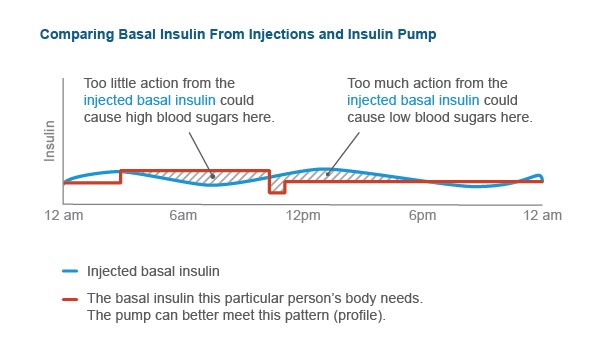Basal insulin covers the glucose your liver makes throughout the day (in between meals) and overnight. People with type 1 diabetes must always have basal insulin to stop
DKA from happening. Here you'll learn about 3 main differences between getting basal insulin from the insulin pump compared to injections.
Getting rapid-acting basal insulin
With injections, you get basal insulin as intermediate-acting, long-acting, or ultralong-acting insulin using a pen or syringe, 1 to 2 times a day.
In insulin pump therapy, you get basal insulin using
only rapid-acting insulin through a cannula under your skin. It gives tiny amounts every few minutes. The insulin pump does
not use intermediate-acting, long-acting, or ultralong-acting insulin.
The graph below is an example of how intermediate-acting, long-acting, or ultralong-acting basal insulin (blue line) from injections might act over the day. The
red line shows the basal insulin this person's body actually needs. You can see that sometimes this person needs more or less insulin than what they're getting from injections.

Graph of basal insulin needs compared to injected basal insulin over 24 hours.
Image credit: Alberta Health Services
The insulin pump can give you different amounts of rapid-acting insulin at different times of the day. It can better match your personal basal insulin needs (red line) and lower how many times a day there's too much or too little basal insulin. This could help you have fewer low and high blood glucose readings.
Changing basal rates for a short time
With an insulin pump, you can lower or raise your amount of basal insulin for a few hours. You can program different doses for different hours of the day to match your body's glucose rhythm. This can also make it easier to stop low blood glucose when you plan to exercise or high blood glucose when you get sick. You can't do this with intermediate-acting, long-acting, or ultralong-acting insulin used in injections.
Some insulin pumps can auto-adjust basal rates, within limits. The guidelines for these insulin pumps are specific for each brand. You still need to count carbohydrates carefully and enter them into these pumps. And these pumps don't automatically stop all high or low blood glucose readings from happening.
Basal rates are reported as "units per hour" in insulin pump therapy. For example, 0.7 units/hr. Most people on insulin pump therapy will program 3 to 5 different basal rates over 24 hours.
Here's an example of 24-hour basal rates that a person programmed into their pump. You can see that at times the basal insulin rates are a bit different:
|
Time |
|
| 12:00AM – 3:30AM |
0.35 units/hr |
| 3:30AM – 8:00AM |
0.40 units/hr |
| 8:00AM – 8:00PM |
0.50 units/hr |
| 8:00PM – 12:00AM |
0.45units/hr |
Setting basal rates
Setting and adjusting basal insulin in pump therapy takes more time and work than injections. It can take 3 to 5 months or more. But after you set basal rates correctly, you’ll usually have fewer low and high blood glucose levels. And you can often be more flexible with when you eat your meals.
Depending on the insulin pump brand, you may need to take the following steps to help set basal rates:
- Miss meals or snacks or follow a meal plan.
- Test your blood glucose more often than with injections, especially overnight.
- Do a basal rate assessment for different times of the day: overnight, morning, afternoon, and evening.
- Adjust rates by fractions of units, for example, raise the rate by 0.1 units/hr.
The goal is to have stable glucose readings that don’t change by more than 2.0 mmol/L over the test period, which can be many months long.
You’ll review your glucose test results with your diabetes team. They’ll help you make any changes and make sure your basal rates are working.
After setting basal rates, you may need to change your insulin-to-carbohydrate ratios, insulin sensitivity factors (formula for correction insulin), or both. So you’ll need to keep food records and do more blood glucose checking.
Remember that people’s basal insulin needs change over time, and you’ll need to do all of these things again to reset basal rates as your needs change.
